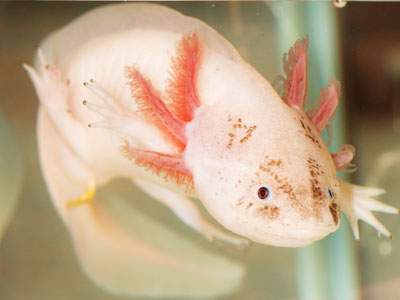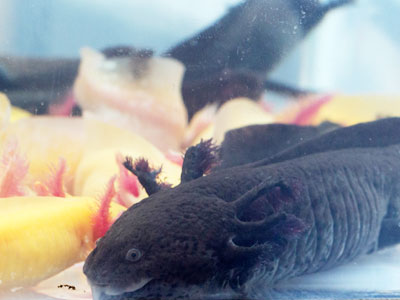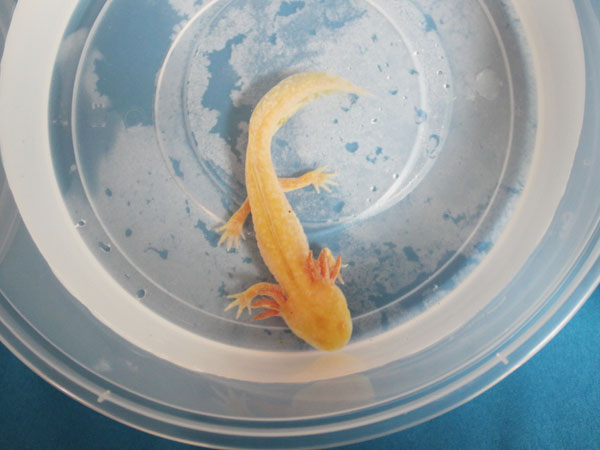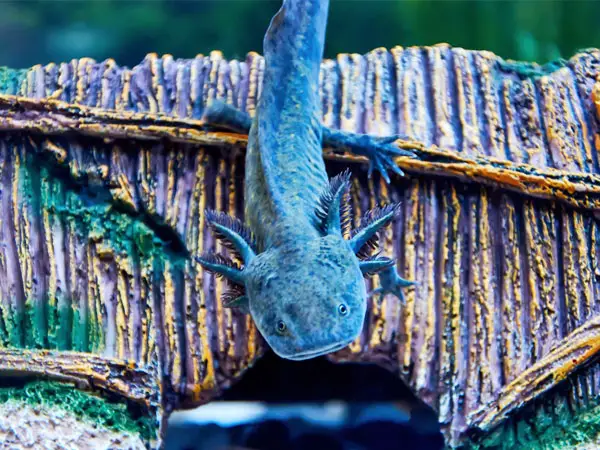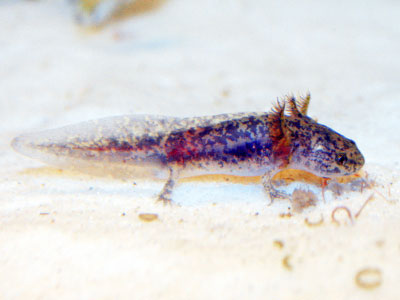
If you’ve owned axolotls before, you’re probably aware that they have specific water and tank requirements, which can be a challenge to accomplish for many beginners.
If you’re completely new to axolotls and you want to raise one or more baby axolotls, I encourage you to dig into this axolotl care guide, where I discuss the requirements of baby axolotls and how you can offer them the best care.
Whether you’re rearing axolotls from eggs or you’ve got yourself a baby axolotl from a pet store, this guide will cover everything you need to know to successfully raise baby axolotls.
How Do Axolotls Breed?
Axolotls breed in late winter and early spring, and their breeding behavior is like a dance of sorts, with the male axolotl leading the female axolotl to take up into her cloaca packets of sperm called spermatophores deposited by the male axolotl. This is an indirect fertilization.
Once fertilization occurs, the gestation period isn’t long — eggs are usually laid by the female 12 to 72 hours later. Female axolotls can lay up to 1000 eggs, but adults must be separated from the eggs as they won’t shy away from eating them.
Some breeders choose to remove the eggs to separate containers and leave the adults in the main tank. Axolotl eggs are tough enough to be moved, so you can move them from the tank to another tank.
You can even remove eggs from rock by carefully slicing the outermost jelly layer of the eggs with your fingernails. Since there are multiple layers of jelly covering the egg, you don’t need to worry too much about crushing the eggs.
Eggs laid on plants are the easiest to remove, simply remove them together with the plant and place them into the new aquarium.
Whether you leave the eggs in the breeding tank or relocate them to a grow-out tank, it’s good to know that the eggs will hatch faster in warmer temperatures. Eggs will take around 15 to 21 days to hatch depending on water temperature.
Keeping the water temperature at around 70 F (21 C) will give you a hatching period somewhere between 15 and 21 days.
Once the eggs will hatch, one of your primary concerns will be to find size-appropriate foods for your baby axolotls.
What to Do When the Eggs Hatch?
In their larval stage, axolotls won’t take on food immediately. First, they’ll absorb their egg yolks, and then, after about 48 – 72 hours, they’re ready to take on live food.
As I mentioned, you could have hundreds of eggs hatching, and while you can keep them in the same tank for a little while, you’ll need to move quickly and put them in separate living quarters.
About 100 hatchlings in a 20-gallon aquarium will do fine, however, as they grow, you’ll need to rehome them in much smaller communities. The smaller, the better to avoid disease and juvenile cannibalism.
Next, I’m going to cover the tank requirements of axolotl juveniles and what you should be feeding them from the first stages of their lives to adulthood.
Baby Axolotl Tank Set-Up
As I mentioned at the beginning of this baby axolotl care guide, it’s important that you get their tank requirements right. These amphibians are sensitive to temperature fluctuations and other parameter fluctuations; therefore, you must keep a good eye on water conditions.
Tank Size
While axolotls are in their larval stage, you can keep quite a lot of them together, but as they take on food and start growing, you’ll need to set up different tanks for them.
Make sure you house them in glass containers rather than plastic ones and try to keep as few of them possible together and make sure they’re well-fed to avoid cannibalism between them.
Once they reach about 2 cm in length (around 7 days) and their front legs start to develop, axolotls begin showing strong cannibalistic tendencies.
Since not all axolotls develop at the same pace, I also recommend separating them based on size, so you can give them a better chance at developing.
You can divide them up based on size when they reach about 2 cm in size because this is the stage when they start exhibiting cannibalistic traits and snap at anything that moves. This can cause damage and even death in smaller axolotls. Obvious signs of axolotl cannibalism include damaged or missing limbs and gills.
You can reduce the number of cannibalistic incidents by limiting the number of axolotls that you keep in the same tank and by dividing axolotl larvae based on size.
Usually, for adult axolotls, the recommended tank size is 15-20 gallons. Of course, a tank this big can house multiple larvae and juvenile axolotls, but as they grow, do make sure to rehome axolotls to larger aquariums, keeping in mind that they’re best kept single since they’re known to nip at each other even into adulthood.
Another way you can minimize cannibalistic tendencies is by having a heavily planted tank and minimal lighting.
Some experts argue that keeping your baby axolotls well-fed will also help avoid attacks on other siblings in the tank.
Water Temperature
Adult axolotls can tolerate water between 59 – 73 °F (15 and 23 degrees C). Their ideal range, however, is between 60 – 64 F (16 and 18 degrees C).
Juvenile axolotls will require a bit warmer water, which will increase their metabolism and help them to grow faster.
Therefore, for baby axolotls I recommend a temperature range of 18-20 C (64-68 F). It’s important to make sure water temperature is kept stable as variations will cause stress and increase the risk of infection.
Substrate
Substrate is a delicate matter when it comes to axolotls. Using gravel in an adult axolotl aquarium can lead to impaction issues since axolotls feed by sucking water in, therefore, sand is recommended.
Unfortunately, sand will not do for baby axolotls since sand is dangerous for them. Therefore, I recommend holding off on adding any substrate to the tank until your axolotls grow to about 5 inches or bigger.
Once they’re large enough that ingesting sand would not be an issue, you can add sand, which is the preferable substrate to axolotls.
You can choose to house them in a bare-bottom tank as well, but I find that adding sand improves the traction of axolotls, helping them move around in the aquarium more easily and potentially lowering their stress levels.
Aquarium Filter
During the larval stage, a few partial water changes per week are recommended. I suggest you monitor water parameters and adjust water changes accordingly.
If you want to reduce the number of water changes, you can try using biofoam filters, which may not be enough for adult axolotls, but they are great for larval axolotls since there is no risk of sucking up larvae.
Experienced aquarists may use hang-on-back filters or canister filters in a large aquarium and tweak the inlet of the filter to avoid sucking up larvae.
They’ll also use a spray bar or other method of dispersing the outflow current, which again is a known source of stress for axolotls, whether they’re still juveniles or not.
Other Water Parameters
Other than water temperature, you should also focus on water hardness (axolotls prefer slightly hard water) and water pH (acceptable range is between 6.5 to 8.0, ideal is between 7.4 and 7.6).
Baby Axolotl Feeding Requirements
Newly hatched axolotls are motionless and don’t take on food right away. They’re about 10-13 mm (roughly 0.5 inch) in size and will absorb the egg yolk they still have, which is why they won’t need food just right away.
What to Feed Baby Axolotls?
Within 48-72 hours after hatching, they’re ready to be fed. Since they’re so little and have tiny mouth openings, their diet must consist of live foods of very small size.
Baby axolotls will ignore food that is not live until they’re about a little under an inch in size. Once they grow to that size, you can introduce other foods too.
At the very beginning of their larval stage, axolotls rely on movement to detect food sources and require live foods.
Later, as their sense of smell kicks in you can introduce them to dead foods. Until then, however, if you’re not able to provide them with live food, they will starve to death.
In the early larval stages, axolotls do not show cannibalistic tendencies either, which would provide them with some source of food, so unless you don’t feed them live foods that are small enough for them to ingest, you risk losing your axolotls.
At this stage, axolotls eat freshly hatched baby brine shrimp, freshly hatched Daphnia and you may even try microworms, although you may have trouble with microworms since they don’t rank as high on their list of preferences.
If you can’t source quality freshly hatched baby brine shrimp or daphnia, I advise you to make your own cultures at home. To always have freshly hatched brine shrimp, make sure to start multiple cultures at different intervals, so you’ll always have something to feed to your axolotls.
Live foods carry the risk of introducing diseases into the aquarium. This is the reason why many aquarists will choose to make their own cultures (you can order brine shrimp culture kits off Amazon) at home over buying them commercially.
Be advised that not all axolotls will enjoy the same foods. I recommend adding variety to increase your chances of getting all axolotls well fed.
It’s important to note that axolotls are carnivores and you’ll need to feed them this meat-based diet even in their adulthood.
Adult axolotls eat a variety of live or dead meaty foods. I mentioned that while they’re still developing live foods stimulate their hunting behavior. In adulthood, they will rely on their sense of smell in detecting food, so dead meaty foods can also be fed to them.
A great food source for axolotls are earthworms, which should be sourced from organic gardens that don’t use chemicals, or better yet, if you have the space, you can even raise them yourself.
Bloodworms, freeze-dried or frozen tubifex, blackworms are other good sources of nutrition, just make sure to get them from fish-free waters or cultures since they can carry parasites and diseases, which can make your axolotls sick too.
You can also feed your axolotls high protein and vitamin fortified pellets (the soft variety) like sinking salmon feed pellets. Pellets that float are not as well received by axolotls.
How Often Should You Feed Baby Axolotls?
Since baby axolotls are still developing, I recommend feeding them once or twice a day. In adulthood, it’s enough to feed axolotls once every 2-3 days, however, while they still have growing to do feeding them at least once a day is recommended.
Conclusion
Baby axolotls can be a handful for the inexperienced aquarist, but you can do a good job at raising them if you research their keeping and feeding requirements.
Female axolotls can lay hundreds of eggs and will often do so when you least expect them to, so, if you’re breeding axolotls, make sure you are well informed on all you need to do to care for and raise baby axolotls.
Before you transfer your baby axolotls to grow-out tanks, I strongly advise you to set up a filter system bearing in mind that small axolotls can get stuck in the water inlet, and make sure you cycle the tank.
Because of the specific water hardness, water pH and water temperature requirements of axolotls, I also recommend that you invest in a quality water testing kit along with an aquarium thermometer.
Make sure to also inform yourself about the potential diseases that can be introduced into the aquarium via live foods and, whenever possible, make your own live food cultures.
I hope this baby axolotl care guide will be useful to you in establishing a healthy environment for your axolotls and you can now more successfully breed and raise axolotls.

